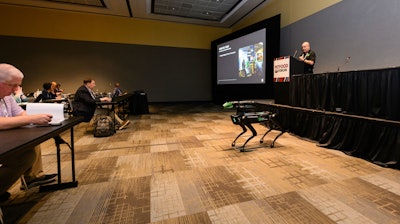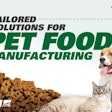
During Petfood Forum 2024 in Kansas City on April 30, attendees gathered to learn about technologies that will be impacting the pet food processing space. Several experts presented their predictions about these products designed to increase efficiencies and improve optimization during the Innovations in Pet Food Processing educational sessions.
Artificial intelligence (AI)
Lynn Verstrepen, director of product marketing, BESTMIX Software, said AI is more than a buzzword. The technology can be implemented step-by-step in the processing space.
Currently, most people don’t use AI daily in their work life, but Verstrepen predicts we will. “With an aging population, a high labor force participation rate, a desire not to work harder and longer, AI will help fix many of these challenges,” she said.
Verstrepen says AI can used in ration, formulation and production. “The ability of AI to predict recipe compositions and optimal production parameters based on predefined quality standards stands out,” she said.
Verstrepen’s overarching message is that AI has the capacity to revolutionize the pet food industry by streamlining processes, ensuring consistent quality and offering new possibilities for recipe creation and production efficiency.
“AI-driven prediction of recipe compositions and production parameters can lead to enhanced operational efficiency, cost reduction and resource optimization,” said Verstrepen. “By utilizing AI, pet food manufacturers can elevate the quality and consistency of their products, ultimately ultimately meeting consumer demands for premium and reliable pet nutrition.”
Automation through autonomous mobile robots
Dean Elkins, senior director, Robotics and Vision, with Gray Solutions, said the successful implementation of automation can aid in efficiency and quality gains within the pet food manufacturing environment.
“The pet food industry is faced with labor shortages and increased means of flexibly meeting consumer demands,” said Elkins. “Automation is the perfect way to augment the needs of the manufacturer to meet this changing demand.”
Automation serves many purposes, including improved manufacturing accuracy, improved product repeatability, gain increased worker productivity, ease of scalability, decrease scrap and waste, reduce human error, and improve safety.
The use of autonomous mobile robots (AMRs) is far easier to implement, operate and maintain than in the past, said Elkins. Known as “steel collar workers,” AMRs can fill a gap in the human workforce.
“AMRs are freely deployable without tethers,” said Elkins. “This area of robotics is growing exponentially.”
Robots can improve package integrity, pressure and temperature, reject products, increase volumetric sampling, accelerate palletizing efficiencies and more.
AMRs can be used for object retrieval, inventory data acquisition via RFI tag reading, temperature sensing and 3D mapping of the facility.
The bottom line: automation in quality improves efficiency, said Elkins. “Automation can detect what humans cannot,” he said. “Automation shows up 24/7/365. It’s very economical to operate, and it can reduce human error. Plus it will generate valuable documentation to protect yourself and the consumer.”
PowerHeater to process alternative proteins
Rikke Miklos, Ph.D., global senior application specialist, Source Technology, said alternative proteins, such as insects and fermented products, differ in functionality and may pose processing challenges and affect product texture.
“With the right combination of alternative proteins and processing technology, it is possible to develop high-quality premium wet pet food products with a meaty texture,” Miklos noted.
Protein functionality is a crucial factor when developing and producing healthy and appealing pet food based on alternative proteins. Two raw materials of the same type with the apparently same protein content and composition may from a nutritional perspective be equal but depending on processing history show completely different processing properties.
“This can lead to challenges in the development process, where the new alternative protein does not match the behavior of the well-known meat proteins,” said Miklos. “In production, the challenge can show up during shift in supplier or even as batch-variations.”
The PowerHeater technology, a unique process for making delicious and fibrous foods, can process various protein categories including plant, meat, seafood, myco, cultivated and hybrid mixes.
“During the years we have built expertise in formulation of recipes and texturization of plant proteins, so they obtain a nice fibrous structure like a meaty chunk,” said Miklos. “We use this knowledge base in combination with our practical experiences and observations with differences in protein functionality, when we develop new concepts based on alternative proteins.”


















